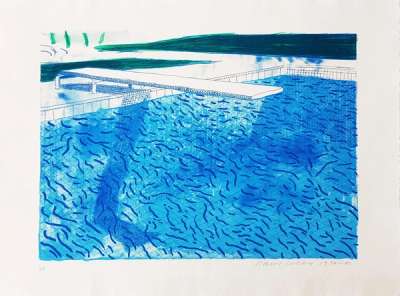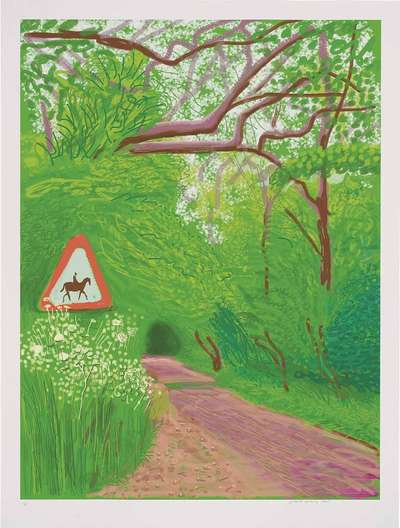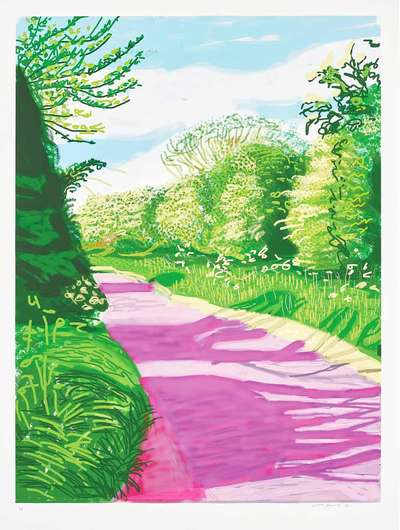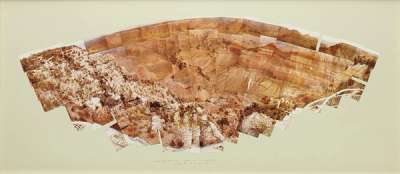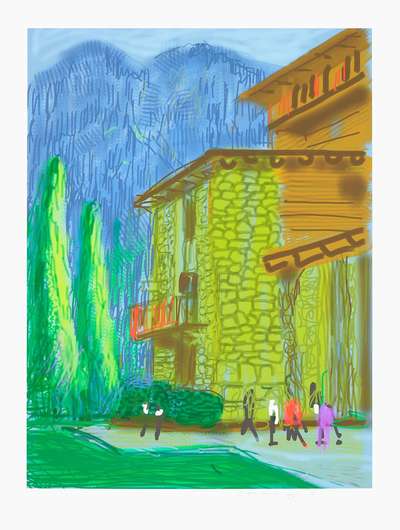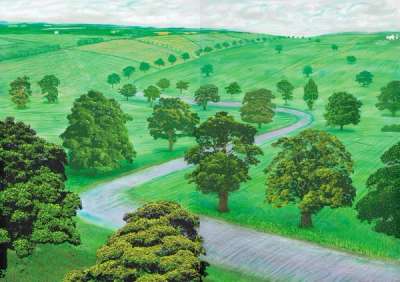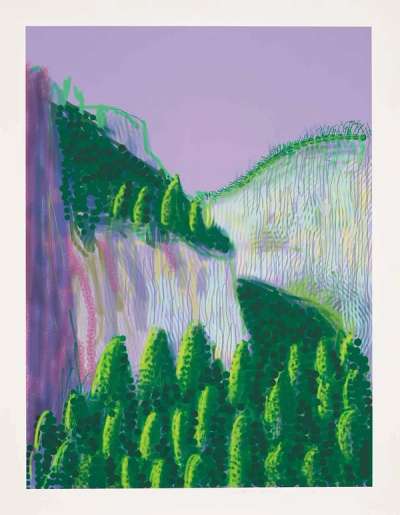David Hockney's Artistic Journey: From Yorkshire to Los Angeles

 A Bigger Grand Canyon © David Hockney 1998
A Bigger Grand Canyon © David Hockney 1998
David Hockney
654 works
David Hockney may be the quintessential British artist of his generation—a lover of our green rolling hills and a participant in London's lively 60's scene—but the artist is hugely well-travelled. Many of his most notorious works are paintings created abroad, whether that was in Colarado, California, or Normandy. In this article we take a journey through some of the most significant places that have shaped David Hockney's artistic career.
1937- 1958: David Hockney, Born and Bred in Bradford
David Hockney was born and raised in Bradford, West Riding of Yorkshire in the North of England. From a very young age, he showed an aptitude and passion for art; with his father, Kenneth Hockney, a conscientious objector, he likely had a liberal upbringing, encouraging his self-expression and interest in political causes. When he was just sixteen, he enrolled at the Bradford School of Art. The school has a rich artistic history, on which Hockney has evidently left his mark: in 2015, Bradford School of Art opened their new 'David Hockney Building' on campus.
Hockney was to return to the Yorkshire landscape throughout his artistic career, finding endless inspiration and a source of constant renewal in its green ruralism, as we shall see. The 1853 Gallery at Salts Mill in Saltaire, located near Hockney's hometown Bradford, still houses numerous pieces from his vast and varied collection.
1959-1963 London: Hockney at the Royal College of Art
David Hockney's move to London to study at the Royal College of Art (RCA) saw the blossoming of his artistic voice and highly personable style. The artist, when recounting the period of his education, compared the newfound freedom of expression to the conservatism of studying painting previously, at Bradford College of Art: "‘Most of us had had very traditional teaching methods up until that point, and when we got to the RCA we wanted to do more physical things and abstraction, which was getting big, coming from America. You could do exactly what you wanted. You could even smoke."
In line with this liberalism, Hockney came out as gay while living and studying in London in 1962, at the age of 23, 7 years before Britain finally decriminalized homosexuality, in the Sexual Offences Act 1967. When Hockney was featured in Whitechapel's famous Young Contemporaries Exhibition in 1961, one of his exhibited works was We Two Boys Together Clinging (1961). The oil painting is a romantic depiction of two men tenderly embracing, in the artist's early smudgy style, which featured cartoonish square-torso figures and collaged text. Having since paved the way for artists who are unafraid to stand for what they believe in, this period was particularly significant for his work challenging and destigmatising gay relationships. His work has influenced LGBTQ artists and activists for many years since.
 We Two Boys Together Clinging © David Hockney 1961
We Two Boys Together Clinging © David Hockney 1961As a British national treasure, his impact can still be seen across the capital: from a prestigious commission to design a stained-glass window commemorating the reign of Queen Elizabeth II at Westminster, titled The Queen's Window to the (less popular) David Hockney London Underground signs project in 2021, there are plenty of opportunities to walk in the artist's footprints across London. He also features in frequent solo, blockbuster exhibitions such as the RA's 'David Hockney: The Arrival of Spring, Normandy, 2020' and the 2017 retrospective at the Tate Britain: 'David Hockney: 60 Years of Work'.
1964: Hockney Moves to Los Angeles
In 1964, seeking an escape from the grey of post-war Britain, Hockney emigrated to Los Angeles. There he found the bright sunlight, crisp shadows, and vibrant, saturated hues, that have characterised his oeuvre for many years. Of all the hues of Hollywood that Hockney was enraptured by, the inviting azure of swimming pools is, of course, the most memorable.
Testimony to the significance of Los Angeles' illustrious pools in coming to shape Hockney's celebrity, are some of the record auction prices that his paintings and prints of swimming pools have achieved. On 15 November 2018, Portrait Of An Artist (Pool With Two Figures) became not only the most expensive work by Hockney at auction when it sold at Christie’s in New York but also the most expensive work by any living artist at the time. The painting – which combines Hockney’s iconic swimming pool and double portrait themes – sold for almost US$30 million more than the previous record set by Jeff Koons’s Balloon Dog (Orange) from 2013. The painting is among Hockney’s most famous artworks, appearing in his 2017 landmark retrospective at Tate Britain and even satirised in the Netflix cartoon Bojack Horseman.
Want to learn more about David Hockney's most iconic and investable prints? Read our latest David Hockney Market Watch here.
 Image © Christie's 2018 / Portrait of an Artist (Pool with Two Figures) © David Hockney 1972
Image © Christie's 2018 / Portrait of an Artist (Pool with Two Figures) © David Hockney 1972Similarly, the artist's 1966 painting, The Splash—a sister painting to the most famous David Hockney painting of all time, A Bigger Splash—sent ripples through the art market when it sold for over £23 million at Sotheby’s in London on 11 February 2020.
From his print works, Hockney's Afternoon Swimming deserves a special mention for its similar freeze-framing of the diver, evoked through a dynamic, explosive white splash. Hockney once said, of the appeal of a freeze-framed splash, “Everyone knows a splash can’t be frozen in time, so when you see it like that in a painting it’s even more striking than in a photograph."
While Hockney's swimming pool paintings are his piece de resistance, they don't deserve all the attention: the artist has dedicated a great number of print series to the subject matter also, using it as a vehicle for experimenting with print mediums. Most notable, are his series Paper Pools and his progressive print series Lithographs of Water.
The former, while not strictly a print edition, can be classed as a series of unique multiples, given Hockney repetitiously records the pool (belonging to his friend Kenneth Tyler, in Westchester County, New York) at various times of the day, perhaps inspired by Monet's Nymphéas studies of his lily pond. Given the craftmanship involved, pressing dye-infused paper pulp into stunning, colour-soaked sheets, it is unsurprising that one work from this series is Hockney's most expensive work on paper ever: Piscine De Medianoche (Paper Pool 30) (1978) sold for £8,705,209 in May 2018 at Sotheby's auction house.
Los Angeles would prove significant also, as the place of meeting of Hockney and Peter Schlesinger, Hockney's lover and muse for a stint, who featured famously in many intimate paintings and prints.
National Parks: Yosemite and The Grand Canyon
While David Hockney's swimming pools are one famous souvenir of the artist's time in California, and the USA, another is Hockney's fixation on the terrains of National Parks, manifest in his plein air landscapes. This body of work include both vast oil paintings and his innovative, new technique: photo collages. Confronted with the grandiosity of places such as the Grand Canyon, Yosemite National Park and California's Antelope Valley Poppy Reserve, Hockney's interest in divesting his art from the single, fixed-point perspective which has come to dominant the visual arts.
In Pearblossom Highway (1986), Hockney creates a photo collage from many perspectives to create an impression of the 'wide-open' American highway. Hockney explored the application of photography (traditionally the epitome of a single -point, fixed perspective) to a previously prevalent representation of space through multiple perspectives; the resulting images, when stitched together feel closer to representing what spaces look like from an embodied position, accumulating gradually the various impressions our eyes might make.
 Pearblossom Highway © David Hockney 1986
Pearblossom Highway © David Hockney 1986Visiting Colorado in 1998 to create his painting, A Bigger Grand Canyon, Hockney applied this same principle, again painting en plein air landscapes so as to best represent what the sublime geological formation looks like from a human perspective—one that can look around and shift viewpoints while doing so.
Evidently, the landscapes depicted in these works, which are often colossally sized works whether painted or photographic, are a critical element. While Hockney's interest in perspective is longstanding, it is unquestionable that the sublime vastness of the American landscape itself offers him an inimitable source of inspiration for his experimentation.
As such, Hockney returned to the Californian landscape in 2010-11, as the inspiration for his vibrant, sun-drenched Yosemite Suite, a print portfolio that quickly became a favourite among collectors.
Late 90s: Return to Yorkshire
Through the 70s and 80s, Hockney travelled between Los Angeles, London, and Paris plenty for his work, though he had bought a house in Hollywood Hills (and an office in Santa Monica Boulevard) as a base for himself and ex-lover Gregory Evans, who remains a friend and business partner to this day. As his mother grew older in the 1990s, however, Hockney found himself returning frequently to his birthplace of Yorkshire to visit her.
Given his visits were, at first, fleeting still, Hockney steadily began painting the Yorkshire landscape from recent and childhood memory. Later he stayed for longer periods in order to complete en plein air landscapes. Hockney's painting of Garrowby Hill (1998) in East Yorkshire marked a turning point: the painting was a resounding critical success, and Hockney was evidently satisfied as he made himself a new home in the seaside town of Bridlington and continued to study his local surroundings.
 Garrowby Hill © David Hockney 1998
Garrowby Hill © David Hockney 1998It was during this period of homecoming that David Hockney created his now-renowned series The Arrival Of Spring in 2011, comprising iPad drawings of Woldgate East, Yorkshire, awash with tree-lined roads, light-filled woods and rolling fields. Hearing of his prolific output, the Royal Academy commissioned him to do a blockbuster exhibition, of which the digital prints are products.
2019-Present Day: A Year In Normandie
After a tragic accident in 2013, in which Hockney's studio assistant died, the artist understandably felt it best to move to new pastures. Having sold his Bridlington house in 2015, in 2019, Hockney bought a studio in and moved to Normandy, prompting bizarre but not untrue headlines in art news outlets such as Artnet's "Artist David Hockney Is Moving to France Because It’s Illegal to Smoke Practically Anywhere in America." While there is truth to the fact that Hockney loves to smoke while working, there are likely other factors, including the beauty of the region in Western France, and Hockney's unfolding interest in the Bayeux tapestry.
Having settled in the picturesque, postcard village of Beuvron-en-Auge, in the pays d’Auge, Hockney has been welcomed (as he is most places) as a local cultural fixture. Partnering with the Bayeux Tapestry Museum (Musée de la Tapisserie de Bayeux), David Hockney's most recent project, titled A Year in Normandie, has been soaking up the provincial landscape as it changes with the seasons. It was a task begun, fittingly 'as the world stood still during the successive lockdowns', and that was ultimately presented as a vast frieze, inspired by the Bayeux Tapestry's narrative.
A Year in Normandie was first shown in Paris' prestigious Musée de l’Orangerie in Paris, home to Monet's archetypal seasonal work, his study of his water lilies through the changes of season: Nymphéas. Since then, the work was unveiled at the Bayeux Tapestry Musuem, evocatively displayed face to face with it's original muse, where it will be displayed until late April 2023.
 Image © David Hockney Foundation 2023 / Installation view at Musée de l'Orangerie of A Year in Normandie © David Hockney 2022
Image © David Hockney Foundation 2023 / Installation view at Musée de l'Orangerie of A Year in Normandie © David Hockney 2022David Hockney lives in Normandy to this day, and, on the promise of works already created there—see, for example, The Arrival of Spring, Normandy 2020—we hope it will be a source of inspiration for the British artist for many years yet to come.
Check out our latest Modern British Prints Market Report for valuable insight into the latest performance of David Hockney’s art as an investable asset, alongside market analysis of other renowned British artists.








